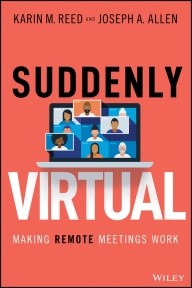How to Make Remote Meetings Work
As the corporate landscape begins to shift from strictly remote and virtual to a hybrid model where some work from the office while many still work remotely, we all need to dig deeper and take a more strategic approach to this new normal. For teams consisting of both remote and in-office employees, virtual meetings are the connective communication that keeps things running.
What does a strategic approach look like? Here are specific must-do’s.
Yes, Look at the Camera, But…
…Not like you are being held hostage by it.

You may have heard you should look at the webcam (not your device’s screen) when you are speaking, so it appears to the people on the other side you’re looking them in the eye. However, it’s not enough to just peer at the lens: You need to focus your energy there, too. The camera is the conduit to your conversation partner.
Too often, people end up staring at the camera lens, which can feel unnatural and unnerving. You wouldn’t continually stare at someone if you were talking in person. Don’t do it on camera, either. Instead, interact as you would with someone face to face, naturally breaking eye contact periodically. Plus, those quick glances away allows you to read the body language of people on the screen. It takes a split second to see if someone is nodding along or nodding off.
Read more: 6 tips to deliver more productive virtual meetings.
Attend to Your PPV
You probably know someone who, before you could say “pandemic,” had already purchased a ring light and a high-end microphone. You probably also know someone who still shows up on webcam as if they were joining the meeting from the deep recesses of a darkened cave. There is a middle way—and it’s not about vanity. It’s about showing respect for your conversation partner.
Your personal production value (PPV) is how you show up on webcam—everything from your lighting to your framing. To ignore it is rude. All these elements impact how effectively your audience receives your message.
- Focus on lighting your face. Don’t force someone to connect with a shadowy figure. Grab a lamp and put it behind your webcam or sit facing a window so your facial expressions are easy to read.
- Make your audio crisp and clear. You can’t hear how you sound to others, but it certainly impacts the experience of fellow meeting attendees. Hop on a call with a candid colleague about your audio fidelity or record yourself on your video conferencing platform and play it back. Let your ears be the judge and look for other audio options, if necessary.
- Select a simple set with depth. Curate your background to be uncluttered and not distracting, but don’t go to extremes. Sitting smack up against a blank wall can make you look like you’re getting a passport photo. To create a depth of field, make sure several feet are between you and whatever is behind.
- Fix your framing. You may have heard it’s important to have your camera at eye level, but here’s the piece many people miss—your camera should not be angled up. If you see your ceiling in the shot, adjust your camera to square up with the wall. We all have seen enough ceiling fans.
Read more: 5 Mistakes to avoid in virtual meetings.
Recovery Time Is Crucial
Digital exhaustion is real but can be alleviated greatly by building in breaks. According to Dr. Joseph A. Allen, a leading meeting scientist at University of Utah, neuroscience confirms that humans need time to cognitively switch gears.
“Running from one complex issue to another is both exhausting and cognitively difficult,” says Allen. “Build in recovery time between each meeting.” Recent research indicates we need five minutes to recover from a good meeting and 17 minutes from a bad one.
Put More Humanity into Meetings
When a team isn’t sharing the same physical space, we lack the social lubrication of bumping into each other in the breakroom or catching up in the hallway. This can weaken connections with our colleagues. To preserve culture and team cohesion, make time for small talk that’s not about business. Consider a take-five moment to kick off a call for colleagues to share what’s going on in their world outside of work.
Virtual meetings aren’t going away, so it’s imperative to make them better. Whether you are a meeting leader or attendee, be an example of what good looks like. You may find your effectiveness at virtual communication is contagious.
Karin M. Reed is the Emmy Award-winning owner of Speaker Dynamics and co-author of the critically acclaimed book Suddenly Virtual: Making Remote Meetings Work.




